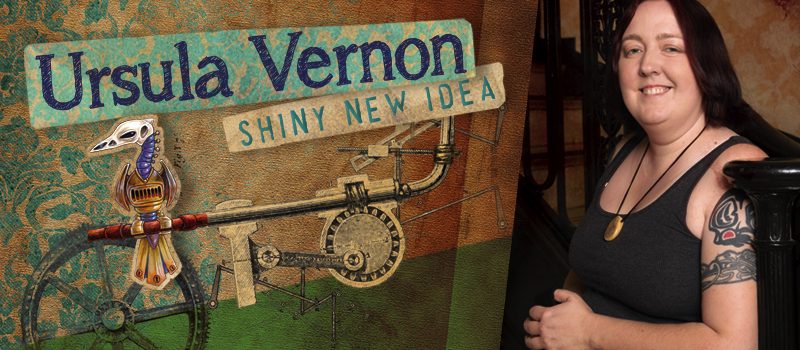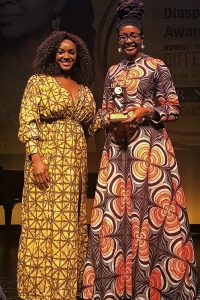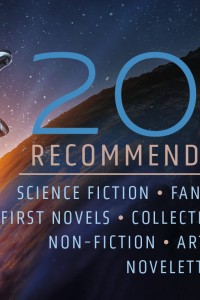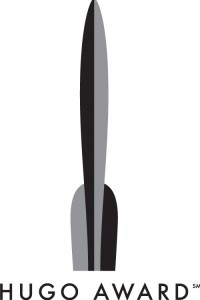Ursula Vernon: Shiny New Idea
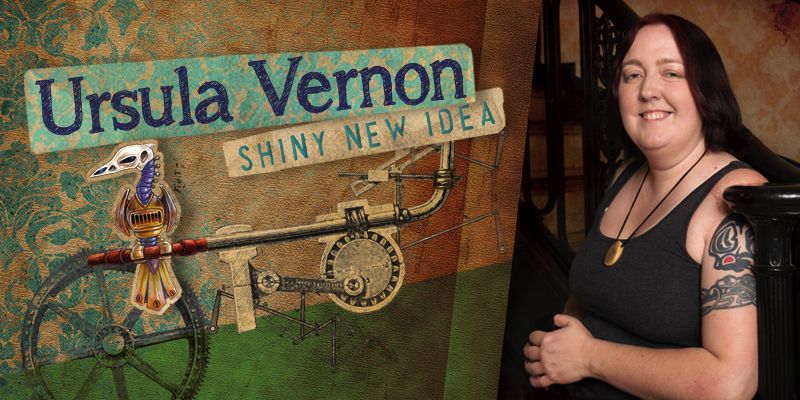
Ursula Vernon was born May 28, 1977 in Japan to a military family. She lived in Europe, Asia, and the Middle East, and grew up mostly in Oregon, Arizona, California, and Minnesota, moving 18 times by age 20. She attended Macalester College in Saint Paul MN. Vernon has lived in North Carolina for the past 17 years.
An illustrator and author, Vernon has written extensively for children and also writes for adults, often under the pseudonym T. Kingfisher. She is one of the field’s most prominent hybrid authors, producing work for both the small and large presses and also self-publishing through her own Red Wombat Studio.
Vernon began her career as a freelance artist, and first rose to prominence in the SF field with webcomic Digger (2003-2011), winner of a Hugo Award and a Mythopoeic Award.
Her debut children’s book was Nurk (2008), and she is best known in that field for the Dragonbreath (2009-2016) and Hamster Princess (2015-2018) series, all illustrated by the author. She also wrote Mythopoeic Award winner Castle Hangnail (2015).
Adult fantasy Black Dogs: The House of Diamond (2007) was followed by sequel Black Dogs: The Mountain of Iron (2011), both as Vernon. Her first T. Kingfisher book was Nine Goblins (2013). Other Kingfisher works include The Seventh Bride (2015), Bryony & Roses (2015), The Raven & The Reindeer (2016), Summer in Orcus (2016), Swordheart (2018), Minor Mage (2019), The Twisted Ones (2019), current Andre Norton Award finalist A Wizard’s Guide to Defensive Baking (2020), and The Hollow Places (2020). The Clocktaur War series is Clockwork Boys (2017) and The Wonder Engine (2018), and the Saint of Steel books are Paladin’s Grace (2020) and Paladin’s Strength (2021).
She writes short fiction under both names. Notable short works include Hugo Award winner “The Tomato Thief” (2016) and finalist “Sun, Moon, Dust” (2017) and Nebula Award winner and World Fantasy Award finalist “Jackalope Wives” (2014). Some of her stories have been collected in Toad Words and Other Stories (2014), The Halcyon Fairy Book (2017), and Jackalope Wives and Other Stories (2017), all as T. Kingfisher.
Vernon lives in Pittsboro NC with her husband, Kevin Sonney.
Excerpts from the interview:
“My mom is a fine artist – a painter. She’s very talented, and she was always telling me that I should take some art classes in college, but I had no desire to go into art: ‘No, I know what that’s like, it’s all poverty, and your friends are weird.’ My mother kept telling me, ‘Just take one art class!’, so I did, and then I spent about 20 years as an illustrator. Occasionally she still says, ‘I told you so.’ I had actually always wanted to be a writer, but I decided to go into art because I thought there was more money in it. I make poor life choices.
“I was writing all along. I wanted to be a writer as a kid, and my grandmother, God love her, got me a subscription to Writer’s Digest, which was one of the magazines for writers at the time. I read it religiously. I had How to Write Science Fiction, Fantasy & Horror by Orson Scott Card, too. I still feel deeply conflicted about them, because they are really useful books, clear and straightforward, but… they’re by Orson Scott Card. I’m sure that a lot of people got into writing science fiction from those books. Sometimes we do good despite ourselves.
“I wasn’t actually in fandom back then, because I am old and the internet was not around, so we did not have any way to find each other. I didn’t go to conventions because they didn’t really occur to me – I hadn’t heard of them. I didn’t even know that fanfic was really a thing, though I was certainly writing it. I had no one to share it with, and in retrospect – thank God. I did not discover fandom existed until my twenties. What I found was furry fandom, because I like drawing anthropomorphic animals, and I discovered there were all these people who were into that. ‘Oh, you have conventions? Wow,’ People told me, ‘You have to go to conventions to sell art.’ The first convention I ever went to as an adult was as a dealer. I started out selling art behind the table, which is a very different world than going as a fan. I still love the furries – they are fabulous people, they spend a lot of money on art, and they kept me fed, basically, for over a decade. They’re super supportive and just lovely people all around.
“My comic Digger was the first thing I did that got anywhere. I had actually written a novel I started when I was 16. I wrote a cover letter and sent it off, because Writer’s Digest told me to. I knew nothing about that sort of thing, and I had a double-spaced manuscript that was ‘this thick.’ I got a nice handwritten note back from the editor that said, ‘This is good, but I’m not sure why we need to be the ones to publish this. I’d like to see more from you.’ I thought, ‘Oh, they rejected it, bummer,’ not realizing that was as good as rejections got. I shoved the book in a drawer and forgot about it and started doing webcomics. I had never thought about comics either, except one day I was arguing with someone on the internet, and wound up drawing an angry little mammal yelling, ‘Oh my God, it has a brain the size of a walnut’ at a dinosaur. I stared at it and thought, ‘Words and pictures! That’s a comic, I’ve read comics, I’ve read Sandman. I could do a comic!’ It was a very slow percolation through my brain. I started a comic that lasted 13 pages, and discovered doing color is really hard. I began Digger purely as an experiment in black and white. I was uploading the pages to a furry art archive called Yerf and kept telling people, ‘Don’t get attached. This is a stylistic experiment, and I probably won’t finish it.’ Seven years and 800 pages later….
“You’ve got to start with the characters – well, I have to start with the characters, anyway. I know there are people who are like, ‘I have a plot, and I will just invent someone who goes through the plot,’ but I need to have the characters and get them talking before I have any idea what the plot is.
“My career has had a weird progression. I was doing Digger, and then I got a literary agent by accident, kind of. I tell people to never, ever base any of their career decisions on what I did, because my path was very unusual. I didn’t have a book, and I didn’t query an agent. A friend of mine, romance writer Sabrina Jeffries, told a joke about me, her weird artist friend reading a romance novel, at a dinner while sitting next to my future agent. Everyone laughed, because I had never read a romance novel before, and she did a monologue on the non-romance reader discovering romance. The agent said, ‘Artist, huh. Does she do graphic novels? Those are really hot right now.’ My friend said, ‘Yeah, she does comics. Here, let me give you her name.’ Sabrina called me up and said, ‘Do you want a literary agent?’ She will never let me forget that my response was, ‘Yeah, sure, what the hell.’ I didn’t know anything about it – all I knew was what I read in Writer’s Digest back in the day, and in the ’80s and ’90s, agents were not such a big thing. A lot more publishers accepted unsolicited manuscripts back then, so you didn’t need an agent nearly as much. I emailed back and forth with this nice agent who said, ‘Do you have representation?’, and I said, ‘Yes? I pay taxes and do not live in Washington DC.’ I was clearly lowering her expectations with every step. She said, ‘I’ve looked at your artwork. I have looked at all the weird little stories you write underneath the art.’ I was just putting stuff up on DeviantArt and writing little blurbs of descriptions that were sometimes like very short stories. She said, ‘Do you think you could write a children’s book?’ I said, ‘Sure, why not?’ Finally she called me up on the phone and said, ‘You are now speaking to an agent,’ It was a month or so later when I said, ‘Wait, are you my agent?’ She was like, ‘Yes.’
“That’s how I got an agent without having written a book. She asked if I could write a book based on a painting of a little shrew in a boat made out of a snail shell, and I said yes. She asked how long it would take, and I thought, ‘Okay, I don’t want to take too long, because I don’t want her to get bored.’ I was used to the turnaround times on art at that point, because I was a freelance illustrator. I said, ‘Can I have six weeks?’ That’s like twice as much as I need for illustrations. She said, ‘Why don’t you take eight?’ I think she was being sarcastic in retrospect, but I had no idea at the time. I just thought, ‘Great, that’ll give me time for edits and revisions.’ I sat down and wrote Nurk, my first children’s book, in six weeks, and then sent it to her, so I had the two weeks for edits and revisions. I don’t think she expected that. It’s a very short book, so it’s not like it took that long to do – it’s only 15 or 20,000 words. Then she sold it. I went, ‘Neat! Is that how this works?’ She said, ‘More or less, yes.’ I came into the whole field from total ignorance. My friends Mur Lafferty and Matt Wallace do a podcast called Ditch Diggers, which is basically about what happens after you get published: you have sold the novel, you are now an author, welcome to your life in the midlist, with all of the challenges that will present themselves, that do not get covered in any of the material for aspiring writers.
“If you reach your peak too early as a writer, that’s when you get a pen name and stuff. That happened to a couple of friends of mine: you do well, and then your work stops selling, and then you reinvent yourself. In romance I think it happens a lot. It does happen in science fiction, too, but maybe we talk about it less. I’ve never had a breakout bestseller, but I do very solidly just because I know every book will sell. Certainly for the works I self-publish, I know they will sell more than enough to justify the writing. Of course, ask me again in ten years.”
Interview design by Francesca Myman. Photo by Beth Gwinn.
Read the full interview in the April 2021 issue of Locus.
 While you are here, please take a moment to support Locus with a one-time or recurring donation. We rely on reader donations to keep the magazine and site going, and would like to keep the site paywall free, but WE NEED YOUR FINANCIAL SUPPORT to continue quality coverage of the science fiction and fantasy field.
While you are here, please take a moment to support Locus with a one-time or recurring donation. We rely on reader donations to keep the magazine and site going, and would like to keep the site paywall free, but WE NEED YOUR FINANCIAL SUPPORT to continue quality coverage of the science fiction and fantasy field.
©Locus Magazine. Copyrighted material may not be republished without permission of LSFF.


